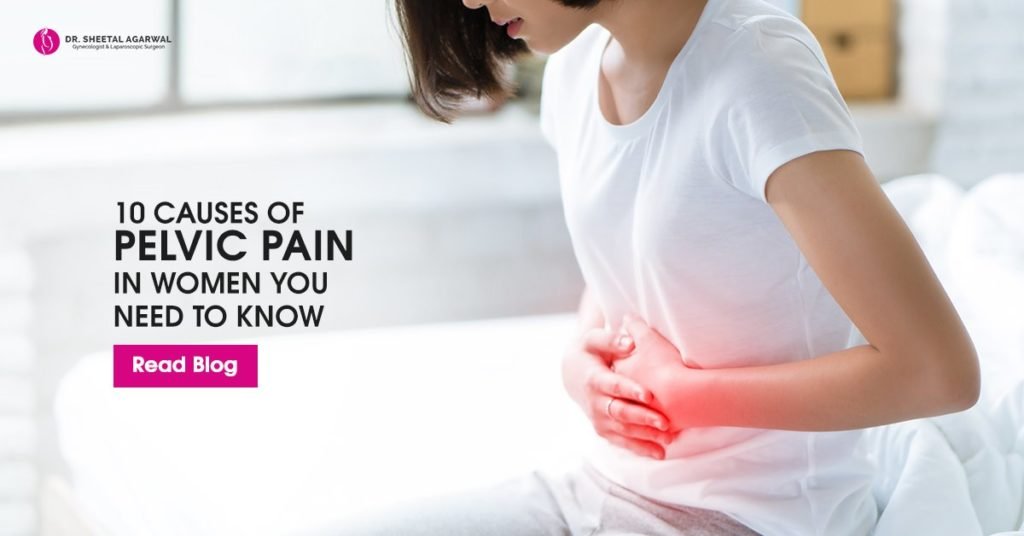What are the causes of pelvic pain? That’s a question many women ask the gynaecologist because of that pounding pain that occurs below the belly button. What’s troublesome is that this pain may even last for about six months and sometimes even longer. That’s not to scare you though. All we want to do is help increase your awareness about its issue and the situation that it might be signalling towards.
The situations may or may not be problematic. They can be menstrual cramps and ovulation. And sometimes pelvic pain in women is also a sign of infections or problems of the reproductive system. Signals of food intolerance (gastrointestinal issues) can also start with pelvic pain in women.
Let’s dive deep into all the major causes of pelvic pain in women.
1. Pelvic inflammatory disease
Known as PID in short, pelvic inflammatory disease is an infection in the womb which can further damage the surrounding tissue. The infection can be a result of an attack of bacteria that came from the vagina or cervix into the womb.
Along with pelvic pain in women, abnormal vaginal discharge and bleeding are signs of this disease. For pelvic pain treatment it’s necessary to treat this underlying issue or else it might create complications during pregnancy or may even increase the risk of infertility.
2. Urinary tract infections
These infections happen when microbes such as bacteria overcome the body’s defence mechanism in the urinary tract. The infections can affect the kidneys, bladder, along with the tubes that run between them.
The symptoms apart from pelvic pain in women are intense and frequent urges to urinate along with a painful and burning sensation while urinating.
For pelvic pain treatment, it’s essential to treat this root cause. There’s nothing much to worry though, as they can be treated with 2 to 3 days of treatment.
3. Menstrual pain and cramps
Pelvic pain in women is mostly a result of menstrual cramps. It can occur right at the starting of a woman’s period. As that’s the time the uterus sheds its lining and has to contract for the purpose thus causing pain. For this pelvic pain treatment, a warm heating pad should be placed on the pelvic area. You can also take ibuprofen or naproxen medicines after consulting your gynaecologist for the same.
4. Endometriosis
Endometriosis is one of the common causes of pelvic pain in women. It occurs when endometrium or the tissue lining of the inside of the uterus, grows outside of the womb.
This tissue outside can react to the hormonal changes that occur when your period starts. Further, this can cause inflammation in the pelvic region and bleeding. Thus, causing pain.
5. Ectopic pregnancy
When a woman is pregnant, it means the embryo is implanted inside the uterus (the womb), but during ectopic pregnancy, it implants itself outside of the uterus and starts growing. This can cause severe cramps and pelvic pain in women. Other signs apart from this are vaginal bleeding, nausea, and dizziness.ginal bleeding, and dizziness.

6. Pelvic adhesions
When two tissues that shouldn’t be connected connect, they form a scar tissue which is also known as an adhesion. This can lead to pelvic pain in women as the body isn’t capable and tries hard to adapt to the new change. The reasons for the formation of this adhesion could be old infection or endometriosis. For this pelvic pain treatment, pelvic adhesions need to be removed for which the gynaecologist might suggest to perform some minimally invasive procedures.
7. Ovulation
Ovulation is also one of the common causes of pelvic pain in women. Although, this time it’s not something pretty serious. During ovulation, the ovaries release an egg and some fluid alongside. This egg then moves down through the fallopian tube and then into the uterus. When the fluid in some cases spreads in the pelvic area, it can lead to irritation in the pelvic region, thus causing pain.
Usually, this pain is on one side of the pelvis and happens during the menstrual cycle. Pelvic pain treatment is not always necessary as it only lasts for minutes in some women. Although, if that’s not the case with you and the pain persists for hours, it’s better to get checked by your gynaecologist to confirm that there’s no serious issue being signalled.
8. Sexually transmitted infections
Pelvic pain in women can also be a result of sexually transmitted infections like gonorrhoea or chlamydia. Apart from the pain in the pelvic region, bleeding between periods, unusual vaginal discharge and painful urination are also some signs of sexually transmitted infections.
9. Ovarian Cysts
If you have ovarian cysts, i.e., fluid-filled sacs in your ovaries, then you are more likely to feel pelvic pain. The cysts occur because of hormonal changes and may lead to some chaos in the body and difficulty in releasing the egg that can create pain. The underlying problem may be PCOS (polycystic ovarian syndrome), so treating it may help you in your pelvic pain treatment.
10. Irritable bowel syndrome
This is a gut disorder that can cause pelvic pain in women along with bloating, constipation, and diarrhoea. It is seen that the trouble usually fades away after a bowel movement. A good diet and lifestyle with minimal stress can help in curing IBS and thus for the pelvic pain treatment as well.
There are more such causes of pelvic pain in women, but they aren’t very common. For example, Appendicitis, Urinary stones, and Uterine fibroids.
If you feel pain in your pelvic region, be it intermittent ( pain that comes and goes repeatedly) or steady pain and cramps; or pain during intercourse, urination, bowel movements and after prolonged sitting, there’s a chance it’s an indication for a severe underlying problem. That’s why, for pelvic pain treatment and to check for other problems, it is necessary for you to visit a skilled gynaecologist.
I, Dr Sheetal Agarwal, have almost 25 years of experience in treating pelvic pain in women. You can consult me for a diagnosis and treatment to relieve your stress and pain.


